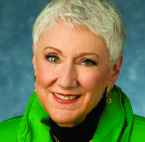Hadassah
President's Column
Date & Time
 Every computer and smartphone today comes with the date and time already set, so that we can keep track of hours, weeks and years. But how we fill each date and time, and what those two concepts really mean, are not always so clear.
Every computer and smartphone today comes with the date and time already set, so that we can keep track of hours, weeks and years. But how we fill each date and time, and what those two concepts really mean, are not always so clear.
Time is infinitely flexible. To a millennial, World War II may seem like ancient history; for someone who lived through the war it can seem like a recent chapter in a life that has gone by all too quickly. Four years ago, when I became Hadassah’s president, I saw my term as a long horizon ahead of me. Today, looking back near the end of my presidency, it seems to have passed in the blink of an eye.
Planned dates can be overshadowed by those that appear out of the blue. I expected that presiding over Hadassah’s Centennial would be a highlight of my term as president. But perhaps the occasion that will stay with me the longest, the moment that inspired the most awe, gave me the greatest sense of honor and—at the same time—humility, was not something I could have foreseen. It came not at our Centennial celebrations, not at a convention or a building dedication, but in front of a small audience at Kibbutz Ketura. It was on Thanksgiving day in 2011, at an event called, simply, “A Date with Time.”
Everyone who is part of Hadassah knows that our doctors, researchers and educators perform miracles that save and transform lives. Our work is a key building block in the resurgence of the Jewish people and the reconstruction of the Jewish state.
But even though our efforts make history, it is equally true that history finds Hadassah.
During the excavations at Masada in the 1960s, archaeologists discovered a jar of seeds from a Judean date palm. Because of Masada’s hot, dry climate, some of the seeds were still alive—even though the species of the tree they came from had been extinct for 1,800 years.
The seeds were put in storage at Bar-Ilan University in Ramat Gan, where they remained for 40 years. Ultimately, scientists treated them with fertilizer. One seed sprouted and was placed in a planter at Ketura.
The tree from that seed flowered in early 2011, and at the ceremony I transferred what by then had been named the Methuselah date palm from the planter into the soil of Israel.
The original seed, the tree and that moment were so rich in connections and symbols that some of them were still occurring to me long after the day ended. Consider:
∗ Planting trees as a way to reestablish the fertility of our land;
∗ A seed that even after it was discovered—liberated—spent 40 years in storage;
∗ The fertile soil is in the desert where Young Judaeans founded a kibbutz;
∗ A living remnant of ancient Israel, now alive in modern Israel, used to pollinate a more modern tree and is now producing dates;
∗ After 60 years of national independence, a single seed bridges the gap between ancient and modern Israel;
∗The central role of Hadassah, which has planted so many institutions in the same soil.
This year, our old-new tree reached a height of 10 feet. Like looking at a child, or a nation, that continues to grow and flourish, I’ll never forget the moment when I was privileged to be part of its creation.
Nor will I forget that I was there representing all of you, and a century of Hadassah women. I couldn’t have dreamed that experience, but I lived it.
I still live by the indicators on my phone and computer, but that day at Ketura forever changed how I look at dates and time. A 2,000-year exile can seem like an eternity—or perhaps 80 eternities, one for every Jewish generation that lived without a national home. And yet, the two temporal extremes of that exile can be bound together by the determination of a people and a seed that refused to die, both enriching the world they live in.









 Facebook
Facebook Instagram
Instagram Twitter
Twitter
Leave a Reply